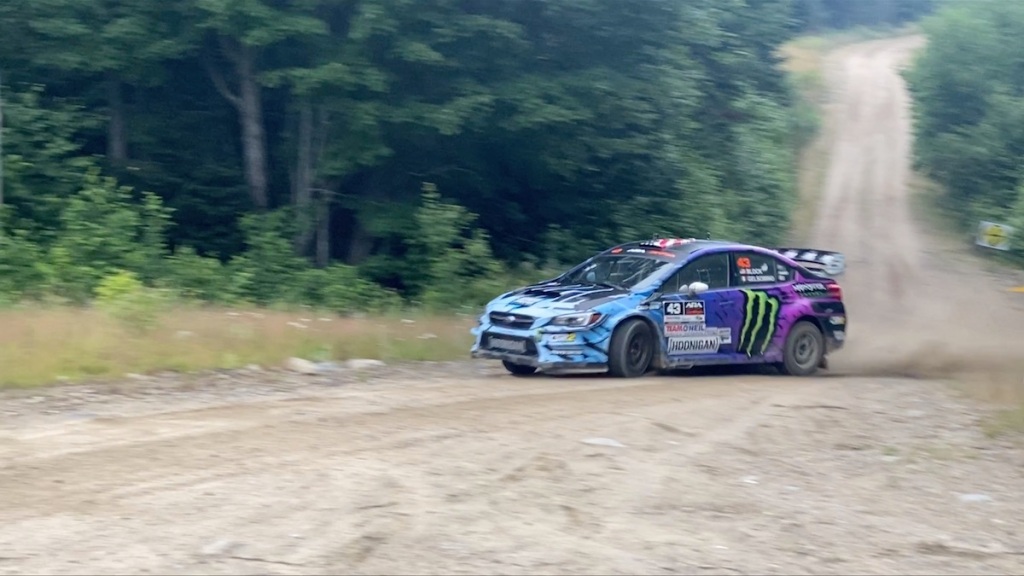The South Arm and Icicle Brook stages are notoriously difficult for 2 meter communications. A big hill in the middle of the stage prevents direct communications between the start and finish, requiring a midpoint relay on top of that hill (usually me) to act as a human repeater. That was unnecessary this year, though, as a result of a bold new idea: move the net to 3.850 MHz, and use 80 meter NVIS to get our signals over the hill.
NVIS stands for Near-Vertical Incidence Skywave. This is just a fancy way of saying that we’re sending our signals straight up and bouncing them off the ionosphere to come straight back down again. We accomplish this by setting up dipole antennas very close to the ground. I traditionally attach my 2-meter J-pole to a 12-foot tall painter’s pole. This is way too low for effective DX communication, but it’s perfect for NVIS. I run it as an inverted-vee, with a pair of stakes on either end holding the wire just four feet off the ground.
Chief of Communications Tim Carter, W3ATB, suggested this idea as far back as 2019, the last running of NEFR. There, he and a couple of other hams informally set up 80 meter stations along the stage just to see how it would work. They heard each other quite well. With the cancellation of NEFR in 2020, Tim, myself, Tim W1FOY, JT N1JTI, and Wayne KA1CPR, ventured out to South Arm on our own to test 80 meters at the actual locations we use during the rally. This was also a resounding success. Starting at 100 watts on SSB, everyone could hear everyone else all up and down the stage. We gradually reduced power in steps all the way to 5 watts. This low power level was a bit marginal, but even at 10 watts we could all hear each other well enough to communicate reliably. You can read Tim’s full write-up of this experiment here.

It was time to put this idea to the ultimate test and try it at NEFR. Tim assigned a number of General and Extra class hams to South Arm/Icicle Brook, enough to run 80 meter stations at start, finish, and all of the usual radio locations. Once again, I was placed at point F, the traditional midpoint relay position. If 80 meters failed, we’d fall back to the 2 meter net and do it the old fashioned way. I ran the 80 meter station from inside my camper van, while Allison, KB1KNG, was on 2 meters. We both set up our HTs to crossband repeat through my Kenwood TM-V71A. Both rigs ran off my house batteries and solar power. To avoid callsign confusion, we both used the club call W1RLY for consistency.
There was some initial confusion as to which frequency we were using for what. We still needed 2 meters not only as a backup, but also for contact with course opening and rally officials, who didn’t have 80 meters in their cars. During the preparation for each stage, we did some relaying back and forth between the bands. When it came to actually running the net during the stage, though, that took place exclusively on 80 meters. Allison relayed the sequence numbers, car numbers, and times to the 2 meter frequency.
The result was a smashing success. For the first time since I’ve been working NEFR, the net, as well as the stages themselves, went off without a hitch. On 80 meters, start and finish communicated directly just like they do at every other stage on 2 meters. For the first time, I had nothing to relay, and was able to step away from the radio (with Allison listening in case I was needed) to take some pictures.

In fact, 80 meters was such a success that for the first time ever, stages had contact with each other and rally HQ. Paul, W1SEX, ran a separate net specifically for keeping all the stages in contact. This is the norm at most rallies, but due to the long distances the stages are from Sunday River, this has never been possible before. Not only has 80 meter NVIS fixed the communication problem on South Arm / Icicle Brook, it’s also opened up new possibilities such as this.
All other stages still used 2 meters, as normal. This isn’t going to change. All hams can use the 2 meter band, and the equipment is cheap and easy to set up. Our 3.850 SSB net is squarely in the General band, which locks Technicians out from participating. It also requires an HF rig and an 80 meter dipole, which is a cumbersome 134 feet long from end to end. We still need Technician class operators, so don’t worry! We’re not putting you out of a job. But if you’ve been thinking about upgrading to General or Extra, we could certainly use your help on the 80 meter nets if you do.


Nicely done! Glad to see this was finally attempted! I’ve been trying to do the same at STPR since 2015.
Next step is putting ferrite rod antennas in the course cars!
LikeLike
Maybe the success at NEFR will help convince them. Let me know if I can help – I was there.
LikeLike